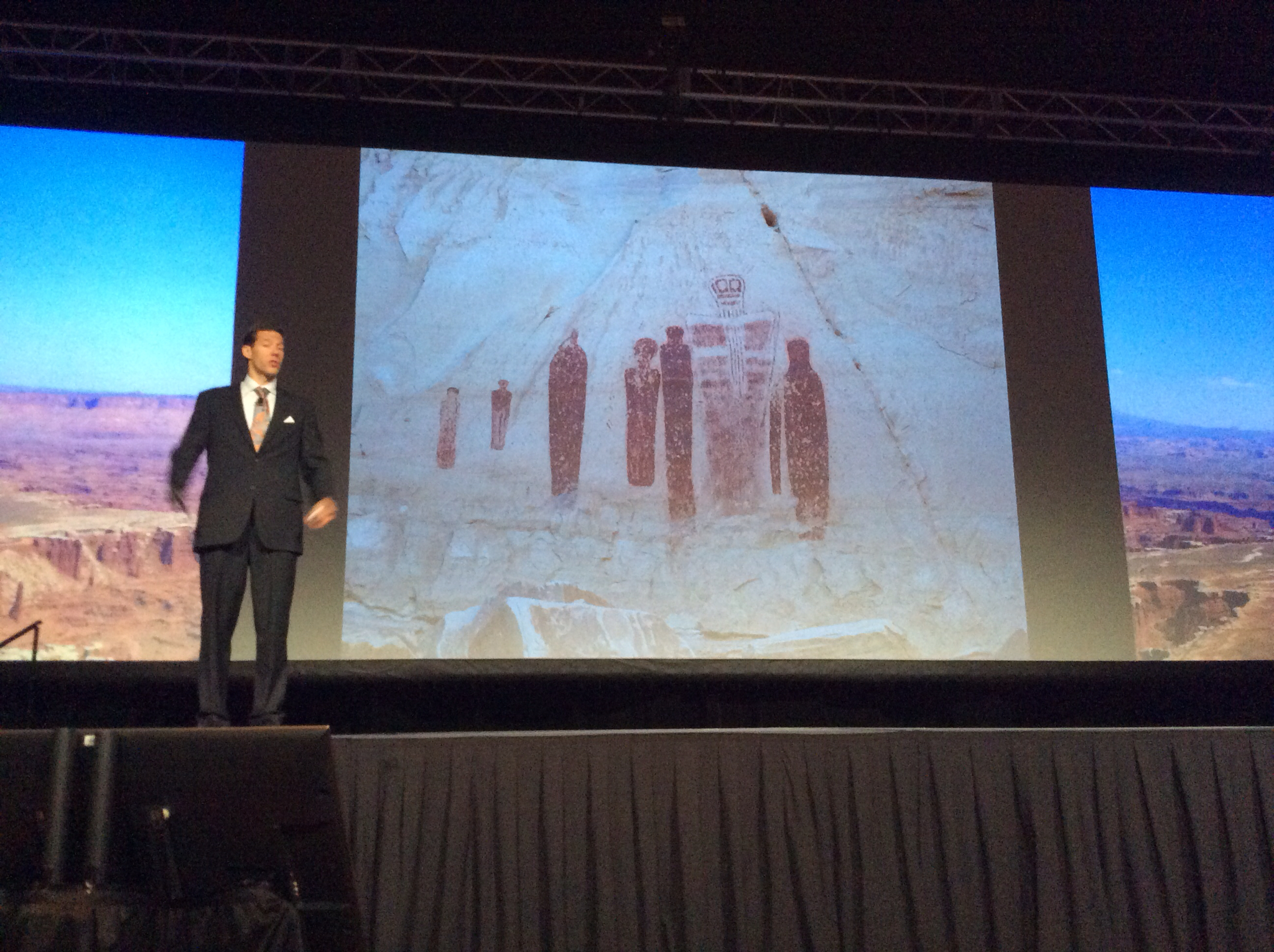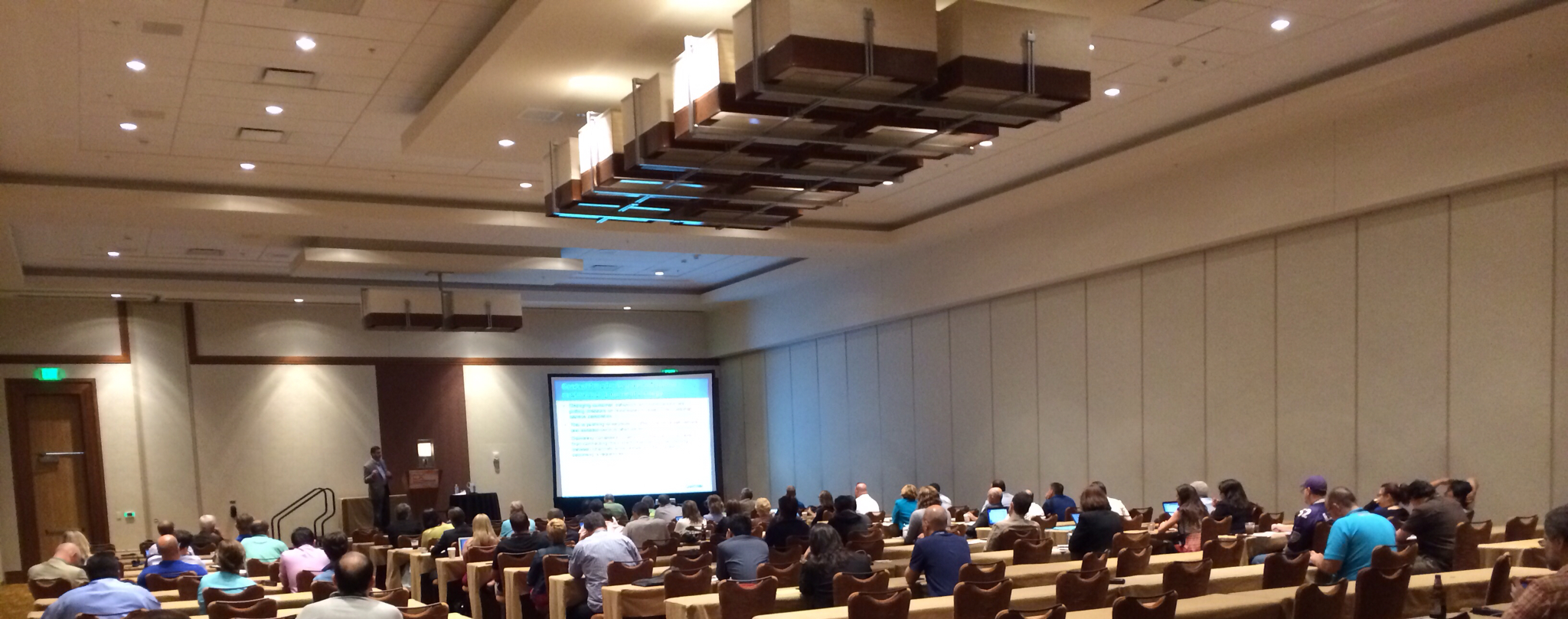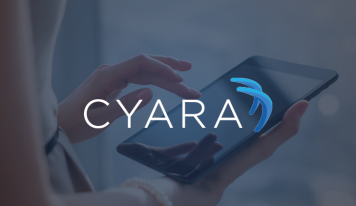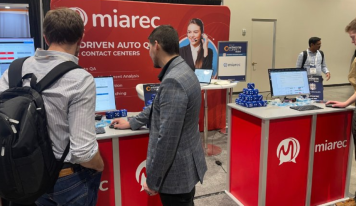I’m here in Indianapolis, Indiana and will be live blogging the Interactive Intelligence Interactions 2014 event where I expect to break some big news. Moreover, I will be the MC of the CX Hot Trends (customer experience) Event which kicks off this afternoon and tomorrow. More to come soon!
8:30 am
Joe Staples, CMO of Interactive Intelligence takes the stage – mentions briefly that this event outgrew the largest JW Marriott in the world and segued into the need to create a great customer experience every time is the objective – not just of this conference but business… 2,000+ people are in attendance at the Indiana Convention Center and the group is made up of partners, customers, media, guests and others. He also mentioned the CX Hot Trends Symposium which is co-produced by TMC (where I am CEO) focused on the latest trends in customer experience. It kicks off later today.
Joe went into some hot trends to be discussed this week such as cloud and social. After discussing many of the benefits of the cloud, he moved on to say 229 friends is the average number of friends a Facebook user has. Continuing, he explained a user can reach 150,000 people if you factor in two-degrees of separation meaning it is more important than ever to keep customers happy.
For those of you old enough to remember, the old rule was a customer who is upset would share the experience with only ten people.
Finally, he mentioned mobile as another hot trend of the week. 1.6 billion tablets and smartphones exist on the market. He says that as time goes on, the need to support these devices and users grows, meaning companies need a mobility strategy.
8:50 am
Aron Ralston the individual whose life story was responsible for the movie 127 Hours: Between a Rock and a Hard Place talks about how cutting off his arm to live after a climbing accident actually helped him gain something, not lose it. He related this experience to other challenges we have in life such as disease, death depression, anxiety and other challenges we all face.
He said we need to embrace our boulders and not allow them to be tragic – referring to the 600 pound boulder which fell on his arm. He then went on to explain the situation surrounding how he became trapped. After meeting a few girls and hiking with them for a while, he decided to part ways in hopes of seeing some cave pictographs (pictured below). He joked that some of his friends told him, next time, always go with the girls.
He went on to explain how his arm got trapped. A boulder came crashing down towards his head after he fell into an hourglass crevice. He tried to shield his head using his hands but his right hand got wedged between the rock and the wall.
From there, he said how he had a conversation with himself about cutting his arm off. As an audience member sitting a few feet from the stage it is tough to not picture yourself in his position. He explains how he had a knife and started to chip away at the sandstone but wasn’t making enough progress. He said he rigged a system with anchors and ropes to increase his leverage up to 6 to 1 but his dynamic climbing rope was like a rubber band pulling a basketball.
9:20 am
At this point he describd how he thought he was going to commit suicide by cutting off his arm – explaining the resulting climb he would have to make, followed by a long walk and drive in a car with a stick-shift. He didn’t think he would make it. He then described the moving video he left, saying goodbye to his parents.
“Its not just what you do in life, its who you are, how you live, how you love,” was my favorite quote of the presentation.
He said he went out knowing something he didn’t know when he went in. At night he said the temperature dropped to 40 degrees at night causing him to shiver. He chronicaled the experience – his water was running low – he had a few bites of food left. On the fourth morning he finished the last few sips of water leaving “”just one other fluid he had left.” He said this is one of the best benchmarks for constituting what is a “bad day.” He said if you aren’t drinking your own urine, its not so bad. He joked, “At least I am drinking my own urine,” which caused quite a laugh from the audience. He said as he started cutting he heard the sound of the movie Psycho in his head. The audience wasn’t sure what reaction to have.
We are now on the fifth day.
Aron then went into the details of cutting off his arm – using the boulder to help cut because the knife was too dull to cut through the bone. It is difficult to explain the feelings I had as an audience member. He then explained how he released himself and stepped out of his grave and into his life. He explained in detail how happy he was. He said the hand was rubbish, it was going to kill him. He said thank you to the rock and went on to explain how the boulder showed him what is important and what is extaordinary about life. He then found a source of water and drank three-liters and filled a container to take more with him. He said he still didnt have enough water and he had lost blood as well.His heart felt like it was going to detonate. At that point, a helicopter landed and saved him, just as he was about to die.
His mother spearheaded a rescue operation which eventually found his vehicle and then him. He said it was a miracle that the helicoper landed exactly when he was at the spot he found himself in. He is back to climbing and showed photos of all the various places he visited since this ordeal.
10:00 am
Mike Pence Governor of Indiana discusses how the state is a customer of Interactive Intelligence, he then talked up the state, its low tax rates, great education system and influx of tech companies.
Don Brown, company CEO took the podium and announced PureCloud, a new multi-tennant cloud contact center solution. In the past, the company offered a cloud solution which was single-tennant in nanture meaning each customer received at a minimum, a hosted solution which ran on a virtual machine in a data center. Now, with this rewrite, the company has a single solution which utilizes Amazon Web Services or AWS to power their solution. Other than costs sa
vings the solution can be used as a way to burst during peak times or alternatively a company can use a premise-based system and add on cloud-services such as a directory which doesnt need to live in their own data center.
Brown went on to say he delights in upsetting the company’s larger competitors and this new innovation should keep them awake at night. The offering consists of these services as of today:
-
Interactive Intelligence PureMatch℠ , a first of-its-kind matching scheme that dynamically matches customer interactions with contact center agents based on multiple attributes and criteria.
-
Interactive Intelligence PureCloud Social Customer Service℠ , which enables customers to view agent profiles and performance – including their service ratings and wait time – then choose the agent best qualified to assist them.
-
Interactive Intelligence PureCloud Directory℠ , a rich corporate directory that makes available deep user profile content (e.g. skills, work experience, location, etc.), and provides bi-directional synchronization with popular systems such as Active Directory, Exchange, WorkDay, SharePoint, and Salesforce. This feature includes native mobile apps for iOS, Android, and Windows 8 Phone.
Going forward we can expect the company to add more services and potentially compete more effectively in the hosted communications space. Up to now the company has done very well in the call center market with enterprise PBX being a small part of the business. Now, they can take on ShoreTel Cloud, 8×8 and others in the market more effectively.Another point Don made was the company is debt-free thanks to their midwestern values and unlike competiors (like Avaya) they have a solid balance sheet – referring the private equity induced debt of the NJ-based competition.11:00 am
Jay Baer, President, Convince & Convert took the stage to talk about the impact of social media on your company. He started with an interesting review on TripAdvisor which he said wasn’t addressed by the hotel. He wonders if this single review was responsible for killing the hotel’s web business.
He says social media fundamentally changes the relationship from master and servant to peer-to-peer as customers have power because they can impact brand perception. He says companies have to change to fundamentally adapt to this change. He says the Now Revolution is the shift he is referring to. “If your company doesn’t have to deal with social customers today, things will change soon.” Continuing, “57% of Americans have Facebook accounts but 56% of people are NFL fans.” 64% of them log in every single day. 65% of people shower every day he said – which caused some laughter here at the event.
@HiltonSuggests was cited as a social account set up by Hilton Hotels which seemingly trolls the internet looking for questions which they can help answer – such as a great restaurant or website to help in a jobsearch. Strategically eavesdropping he said is the future – where you do something which doesnt result in immediate gratification… Hoping for a return at a later time thanks to good will.
57% of people expect a response in an hour when they have a problem – he says companies will have to evolve to deal with this new reality. Fast is more valuable than good he says. 17% of people would reccomend slow but good custoemr service. 33% of people would reccomend slow but ineffective service. You will adapt to serve customers at any and all times.
Some companies are concerned about embracing social because someone may say something bad about their company. The analogy is hanging up whenever a customer calls to complain. He said that if your company/product sucks, social isn’t your biggest problem.
56% of people will interact with a company via social media – he says you will eventually have to do this and if you do it soon, it will be a differentiator. He says this is the same thing that happened with phone and email, customers will demand it.
11:35 am
Joe Staples takes the stage again to talk about the results of the Customer Experience Makeover – they received 85 responses/entrants where companies explained why they should be selected, etc. The three finalists are:
LawnSavers: Organic lawn and garden care experts – he said their photo was the the one most likely to win
BidPal: a high tech company with a low-tech call center.
Loreal Espana:
The winner is BidPal
CX Hot Trends Customer Experience Event
Melissa O’Brien with IDC discussed how the cloud contact center is more agile and flexible allowing lower cost, more flexible handling of agents – via various channels and the hiring and deployment of home agents. Companies in-turn are able to get access to features on demand and only pay for what they need.
Moreover, although other channels besides voice are growing in importance, voice is still a major factor in customer care. Social is at the tip of the iceburg phase and companies are struggling to determine who owns this area and how can a company create a process allowing them to move back and forth between marketing and other departments/divisions.
She says creating meaningful engagement is important – not just pushing out content such as coupons etc.
Moreover she says there are lots of missed opportunities companies need to take advanatage of as you can see belo
w.
As automated interactions increase, there needs to be emphasis to ensure there is a positive customer experience.
There needs to be clearly defined goals, a C-Suite level person in charge of the customer experience and investments in training, evaluating and hiring to ensure there is expertise in multichannel interactions.
In short, it seems there is a great opportunity for companies to improve their customer care and the cloud is a great way to go about improving service levels, lower cost and create a more nimble organization.
2:45 pm
Drew Kraus with Gartner takes the stage to tell companies how to evolve from a brittle, unresponsive contact center infrastructure where the architecture is not flexible and companies are afraid to touch anything. He said this eventually leads to a brittle customer center experience.
He says mobility is changing the market – proactive contact applications are changing the ways companies can provide service – including dramatic multichannel improvements.
There was a lot of discussion about how to deploy an effective multichannel contact center strategy – determining needs is the starting point. Moreover, companies need to take an inventory of the technology they currently have deployed. Quite often he said, companies don’t realize they have an email application in the travel department and a dialer in the collections department.
In conclusion, your company needs to respond to customer needs in a non-brittle way as customer needs change and your processes need to change with them. Applying consitent technology gives consistent service to customers so they feel engaged and they will feel you know and care what their needs are. This in-turn will increase loyalty.
Omnichannel is more strategic than multichannel as it allows the context of customer communications to persist across channels. Start with mobile for example and ask for assistance via SMS, get a proactive “help” SMS if you are a platinum customer, etc.
3:45 pm
More and more people however are expecting near real-time social customer service. He went on to discuss how different companies list their hours of Twitter customer service – pointing out some companies that you would expect to have the most problems on weekends seem to close early on those days.
A customer trying to get customer service on Twitter from British Airways couldn’t because their social customer service was closed. As a result he took out an ad and showed it to a million people on Twitter discouraging them from doing business with the company. Baer reiterated the importance of embracing social early.
Speed is critical in inserting yourself into conversations online – in the Hilton Hotels example earlier, it was pointed out that if you wait too long, the customer can no longer benefit fom your suggestions.
He says there needs to be distinct hand-offs between marketing and customer service. There also needs to be distinct handles for each. For example RaysPizzaHelp, HandymanSupport, etc.
He says being fast will keep marketing from taking over social media in your company. If not, the marketing department argues they are revenue generating and subsequently take over social from the contact center/support desk.
Baer cited numerous customer service problems from major companies – some which responded the day of the negative tweet but this was deemed to late by the users. In one case the situation escalated to the point where reporters called the company for more information.
Klout was used as an example of a service which can be used to determine the importance level of a commenter. I’ve commented about Klout before – it seems to be a good way to determine how much influence a person has.
Perhaps one of the most profound take-aways for me is that the contact center may be facing true competition from the marketing department and although customers may not care who services them, it behoves forward-thinking ocntact center executives to stay ahead of this train – or potentially get run over by it.
Day 2
June 4, 2014
Keith Dawson at Ovum takes the stage to talk about the importance of mobile in your contact center – more specifically the mobile customer experience.
He discussed a model he built in terms of the corporate integration of mobility and care.
74% of consumers use at least 3 channels to engage – devices and capabilites have empowered users almost magically. Companies have to deal with this challenge and most aren’t dealing with it in a way which is efficient at scale.
He cited an example of how a customer care site presents a phone number to a consumer who can’t click to call it on a mobile device which forces customers to memorize the number and then dial it in another application.
Another great point is mobile is more important than social because social lives on mobile – so companies and contact centers need a unified approach which works well on mobile. He continued to explain the continuity of experience needs to seamless across chat to mobile IVR and other modes. He says, if not, you increase friction for the customer.
Smart Connected Interactions are what he he referred to as the next frontier of service – mobile devices give rich information on context such as location and a company can use this information to determine a great deal even before a call is placed. He says, this integration of marketing and customer care should be branded.
To conclude, a mobile czar is needed as well as collaboration with IT, marketing, customer care understanding there is a moving target here which will never be completely solved. He says integration at a cultural level is crucial – companies have to make sure mobile users don’t have a bad experience. You need a forward-looking plan to make it work.
9:45
Phil Edholm from PKE Consulting takes the stage to discuss the power of WebRTC in the enterprise. He starts off with a bit of history on the IP communications space and segued into real-time communications on the web and Google’s involvement int he standard – thanks in-part to the GIPs acquisition they made which powered much of the communications industry.
Phile shows the WebRTC triangle as opposed to the traditional trapezoid. He says this is when he realized the power of this new technology. In ten years the world of communications is going to change – users will talk to each other directly – no server needed he says. He says the last tech which required servers was designed in the eighties – it was email,
He went on to explain the Mayday button from Amazon while pointing out any contact center can seamlessy add WebRTC – just by considering it as an endpoint.
Video becomes an adjunct thanks to WebRTC in games, customer service and other situations. Phil thinks WebRTC will change just about everything.
To see Phil live, be at WebRTC Expo June 17-19 in Atlanta where Phil has partnered with TMC to provide the best educational environment we can for the global WebRTC ecosystem, carriers, enterprise, web companies, contact centers, etc.
The big disruption from WebRTC will be how we do business – the next Facebook, Google etc. VoIP is just voice over the internet while WebRTC is voice “webified.”
He says we need to be careful how we deal with context because companies can have tens of thousands of web pages and can initiate a call from any of them going forward. In order to handle these conversations, companies need to know the class of customer which are generally concierge, web class and loss class. Basically the more you spend, the better your service. Similar to how an airline tells non-concierge customers that they will have to pay $50 for an agent to make a phone change for you or you can use the web and do it for free.
Bottom line – WebRTC will be revolutionary – be sure to adopt it ASAP.
10:45 am
Paul Stockford takes the stage to discuss performance metrics in the socialized contact center. He says the trends in the contact center are obvious – social media is unavoidable and very soon 100% of contact centers will support it.. Having said that, customers are still expecting a high-level of service in this new channel but the definition of “timely” is difficult to measure and/or ascertain. The definition of immediacy changes dramatically he says.
He gave an example that Delta Airlines took three-days to respond to a problem that Interactive Intelligence CMO Joe Staples had – far too long.
He said quality monitoring is needed in the world of social – checking on tweets, Facebook posts, etc to rate agents. Moreover, social media monitoring software – there are more than 50 alternatives on the market help companies figure out how they are doing. He says they can also measure and track sentiment – not just frequency.
Speed of answer is one metric – but he points out it is difficult to determine what is appropriate. The average speed of answer should be within four hours. Airlines want 85% of tweets responded to in the same day while Virgin Airlines want an 85% response rate in 15 minutes which personally is not surprising.
1:45 pm
Sheila McGee-Smith of McGee-Smith Analytics hosted a session focusing on embracing proactive customer care where she talked about customer effort – are we making it too difficult for customers to achieve their goals? Moreover, can this measure determine how likely this customer is to purchase from your company again?
Companies, she says, should have lists set up to answer questions from customers. She cited the carrier in her area which doesn’t have great broadbnad speeds. She calls them monthly to ask if they have improved the service and they never offer to add her to a list which would alert her when the new service is ready.
SouthWest was mentioned as an airline which does a good job at this engaging in 35M voice, text and email interactions. Companies need to find the low-hanging fruit – for example, is a customer’s
credit card number about to expire? Another is reminding customers of bills which are ready – in some cases allowing you to quickly pay for the addition of this new communications mechanism.
2:45 pm
Melanie Turek of Frost and Sullivan discusses video support in the contact center. She started by saying there isn’t much video in the contact center today and a poll of the audience validated her company’s research. She beleives that as companies begin to embrace mobile and social, some will embrace video as well.
Customers for their part don’t seem to want to show themselves to the contact center. Moreover, it is expensive and complictaed to deploy video in the contact center from a backend perspective. We are of course discussing live, not prerecorded video which is being adopted by companies who use this as a support step prior to escalating to live chat.
3:45 pm
That’s all folks – a great event. Thanks for being part of it.




















